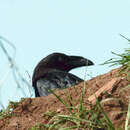Biology
provided by Arkive
Ravens are well-known for their intelligence, they are also very playful birds, performing mid-air acrobatics, playing 'games' with each other's beaks and passing stones to each other (5). They eat a wide variety of food, including carrion, small vertebrates, insects and refuse, yet carrion is the most important component of the diet (6).
Pairs stay together for life, and defend a territory from which they exclude all other ravens (5). Breeding begins in February or March. Following a mating display involving posturing, mutual preening and beak caressing, the pair make a solid nest (or renovate the previous year's nest) of sticks lined with moss and mud (5). Clutches contain 4-6 blue-green eggs, one of which is laid each day until the clutch is complete (5). The female incubates the eggs for up to 20 days, during which time she is fed by the male (5). Both parents feed the chicks, which stay in the nest for up to six and a half weeks (5). Ravens do not tend to travel widely; during winter adults remain in their breeding territory, and young birds do not tend to disperse further away than 20 miles (5).
A rich wealth of folklore and mythology centres on the raven; King Arthur is said to return in the form of a raven, Noah sent out a raven from the Ark to fly 'forth and fro until the waters were dried up from off the earth', and the Norse god Odin had two ravens who flew the world to return to his shoulders and whisper what was happening into his ears (4).
Conservation
provided by Arkive
No specific conservation action has been targeted at the raven, although it is protected by the Wildlife and Countryside Act (1981); under this act it is illegal to intentionally kill or injure wild ravens or remove or damage their nests or eggs (3).
Description
provided by Arkive
The raven is a magnificent bird; bigger than a buzzard, it is the largest passerine (perching) bird in Europe (2), and is deeply embedded in mythology (4). The glossy plumage is entirely black with greenish and lilac sheens. The large bill is very thick and heavy looking (2), the wings are narrow, and the tail is wedge-shaped (2). The sexes are similar in appearance, but females are somewhat smaller than males (5). Juveniles are duller than adults, and have a variable amount of brown in the plumage (5).
A variety of vocalisations are produced, including a 'korrp' call and a 'krack-krack-krack' of alarm. In spring and during courtship, a range of unusual sounds can be heard such as clucks, a 'klong' and pops (2)(5).
Habitat
provided by Arkive
Occurs in a range of habitats, but seems to prefer upland areas, moorland, and coastal cliffs (6), as well as wooded lowlands (5).
Range
provided by Arkive
The raven is found only in rural parts of its former range (8); in Britain it is restricted to the west and north (6). It also occurs in Europe, northern Africa, Asia (except south and southeast Asia), Greenland, Iceland, North America and Australia (5).
Status
provided by Arkive
Receives general protection under the Wildlife and Countryside Act 1981 (3). Included in the Birds of Conservation Concern Green List (low conservation concern) (7).
Threats
provided by Arkive
This imposing bird has been persecuted for years by farmers and gamekeepers; as a result it has withdrawn from many of its historic haunts (5). It is very rare that they will attack strong, healthy livestock, yet ravens are still perceived as a threat and are occasionally shot despite being legally protected (5). Other threats include collisions with overhead cables (5).

